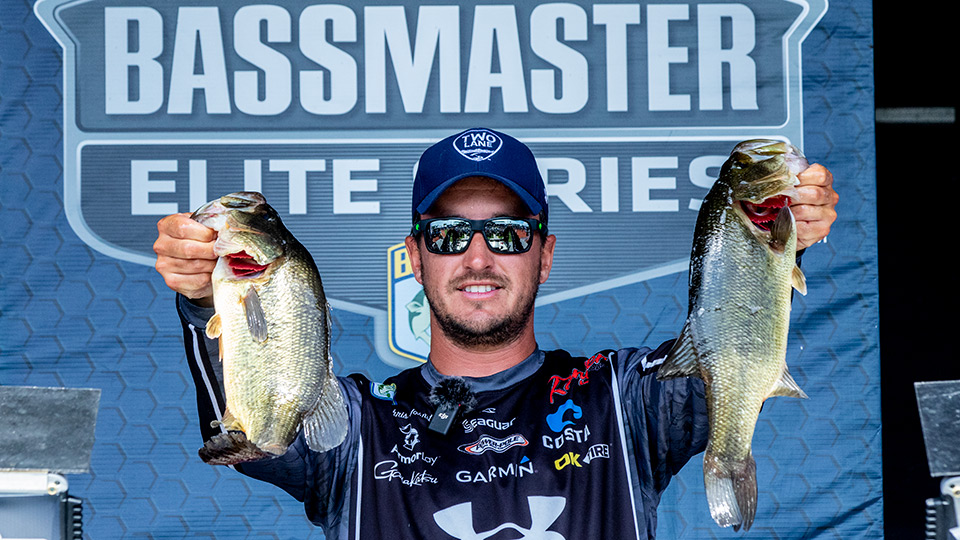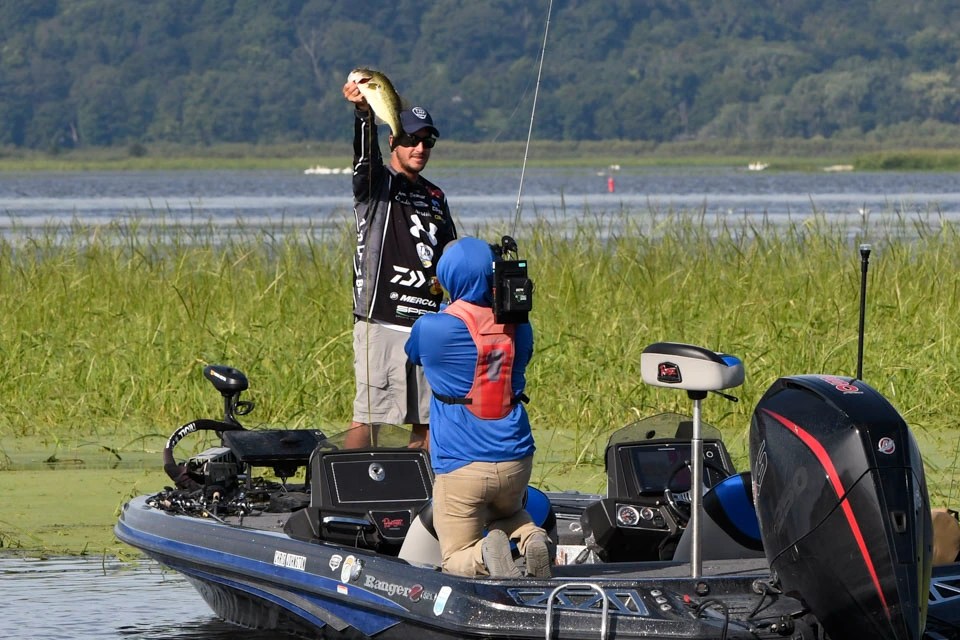
The assumption is understandable. Mention Chris Johnston’s bass fishing prowess and we must be talking about smallmouth, right?
Sometimes, a lot of times, but just not all the time.
Fact is, despite making history as the first Canadian to win a Bassmaster Elite Series event with his 2020 victory at the Bassmaster Elite at St. Lawrence River, Johnston cut his bass-fishing teeth on Canada’s green goblins.
Hailing from Otonabee, Ontario, Johnston’s comments from the final Elite event of 2022 on the Upper Mississippi River, where he finished second, validate his largemouth success.
“Believe it or not, I grew up fishing largemouth; flipping reeds and milfoil and frogging. For the first 20 years of my life, it was all largemouth fishing. The smallmouth didn’t take off in our waters until I was about 17 to 18 years old.”
Speaking of the grass-focused game plan that yielded a season-ending second-place finish, Johnston said: “I love this style of fishing — putting on 65-pound Seaguar Smackdown braid and just going and having fun.”
A change of pace
If you’re wondering why largemouth dominated Johnston’s youth, it was a different time for Canadian fisheries. Smallmouth were always present, but a couple of non-native game changers had not yet made their debut.
“Gobies definitely (impacted) the Great Lakes, but in a lot of Canadian waters, it was zebra mussels, which got in about 20 years ago and cleaned up a lot of the water,” Johnston said. “Our lakes used to be a lot more stained and dirtier which favored largemouth bass, but now there’s a lot of clear water, and that’s better for the smallmouth because they’re sight feeders.
“Growing up, from as soon as I could walk until my teenage years, it was mostly largemouth, with some smallmouth mixed in; largemouth dominated around here, and that’s what won all the tournaments. My dad loved largemouth fishing, so I grew up frogging lily pads and flipping a jig like I did at La Crosse.”
Johnston said weedy fisheries such as Sturgeon Lake, the Tri-Lakes and the Pigeon River offered prime largemouth training waters, much of which looked a lot like the Florida lakes he’s come to love.
“Within 45 minutes of my house, there are probably 30 different lakes, and a lot of those are still largemouth fisheries,” Johnston said. “In some of these, the smallmouth have taken over. You can still catch largemouth, but you need smallmouth to win tournaments.”
Lessons applied
So, what did Johnston’s early years of largemouth bass fishing teach him?
For one thing, he’s adamant about prudent habitat selection. At La Crosse, he knew the only way to dial in consistency in the vast Mississippi River habitat was to keep himself in promising areas and trust his bait’s reliability.
“You had to be in areas that looked like big-fish spots, and the challenge was you might have to fish that stuff for an hour to get one bite, but they were typically big ones,” Johnston said. “The key areas I was looking for were sandier bottoms around the reeds and pads.
“On the Mississippi River, it seemed like the bigger bites came on the frog, so you had to put that in your hand and go to work.”

Obviously, those grassy waters of his youth helped prepare Johnston for many of the heavily vegetated southern fisheries he’s faced throughout his Elite career. Strong finishes at the St. Johns River (second place, 2019 Elite); Lake Guntersville (10th, 2021 Elite); Pickwick Lake (19th, 2022); and Chickamauga (20th, 2022) have demonstrated his largemouth prowess.
Specific lessons and applications are many, but here’s a sampling of Johnston’s largemouth logic.
Know what’s below: According to the Dairy Farmers of Ontario, theirs is the largest segment of local agricultural output. That said, Johnston favors a different type of cheese — actually, the yellowish algae forming over dying hydrilla. With the subsurface mass diminishing, cheese indicates bass-friendly habitat amid otherwise super-dense vegetation.
“It may be 50 yards into a mat, but the fish will go to it, as long as it has enough water because it’s hollowed out,” Johnston said. “Sometimes you have to fish the whole flat to find the sweet spots, but once you find them, there’s going be a lot of fish there.”
Get to the point: In just about any scenario, a mat’s outermost tips will be the deepest parts of a mat. Therefore, if a grass mat is mostly too shallow to consistently hold fish, or if it lacks cheese or other interior attractions, Johnston will focus his efforts on those outer protrusions. Recognizing these points as high-percentage spots, he’ll crisscross them to see if he can establish enough consistency to warrant attention on tournament day.
When it’s bare: Grass equals bass, but beyond this ageless axiom, Johnston knows there’s often some secondary element that attracts and holds fish. Diligent searches will dial in the good stuff, but it’s a lot easier when you take the tarp off the field.
“A big thing that people up north do on grassy lakes — it works for smallmouth and largemouth — is look for sweet spots after ice-out when there’s no grass yet,” Johnston said. “In the summer, our fish are in the grass, but they’re in specific areas, and you can’t find those area by graphing them when they’re covered in grass.
“You can go graph these big grass flat areas, and you can pick off rockpiles, stuff you see out to the side and mark them. Then you come back in June and July when all the grass has grown over and it all looks the same, but you can fish those rockpiles and those are the best spots in the whole flat.”
Noting this strategy of his youth has served him well on lakes such as Oneida, Johnston said the ability to go directly to a key spot makes him more efficient. While others are trying to locate high-percentage areas by blind fishing and connecting the dots, he starts his day with a reliable road map.
Feathered friends: Speaking of grass, the first quarter finds Johnston on the lookout for coots, which often disclose promising areas. Diving to eat subsurface hydrilla, this short, black waterfowl save him a lot of time by immediately indicating whether a bay or pocket is worth a look.
“Early in the year, when the grass has not grown up yet, the coots will show you where the subsurface grass is,” Johnston said.
Also, pelicans and gulls rarely miss bait schools, so concentrations and surface level activity indicate forage below. Find the bait; find the fish.
Similarly, Johnston’s always on the lookout for wading birds, as they too will indicate baitfish. Spotting herons and great egrets (the tall white birds) bodes well during springtime when they’ll give up a shad spawn.
Personal notes
Ask Johnston for his favorite largemouth scenario and he’ll point to one where he devoted many a youthful cast. He’s talking about reeds off the bank in 2 to 4 feet with pads or blown-in vegetation. The secondary cover burns out holes in the reeds and provides vertical structure with horizontal cover.
“I grew up fishing that stuff — these are high-percentage spots,” Johnston said. “On cloudy days, you can catch them around the edges, but as soon as the sun comes out, they want to be in that shade. That’s when I’ll flip or punch the mat.”
Johnston says his favorite Canadian largemouth waters are found in the Bay of Quinte on Lake Ontario’s northeast side. In the U.S., he has to give it up for Florida’s biggest freshwater body.
“I like fisheries with grass, so I’m fond of Lake Okeechobee,” said Johnston, whose personal best 9-plus-pounder came from the Big O, also the playing field for the first 2023 Elite event of the season.
His favorite time of year? The Florida spawn.
“There’s always a chance to catch a 7- to 10-pound bass.”





